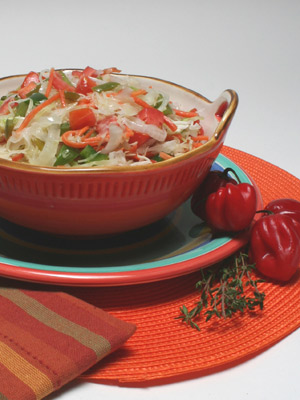8 Quick Pickle Recipes to Spice Up Your Thanksgiving
Quick pickling is an easier way to enjoy the crisp, zesty pickles you crave without the time-consuming task of preserving and canning. And cucumbers are only the beginning. There are very few rules in the world of quick pickling. Make a brine, choose your fare, and within a day you can enhance salads, sandwiches, and appetizer trays with your cool, colorful creations. Make sure to keep quick pickles refrigerated, and use them within a month.
For the brine:
- 2 cups of water
- 1 cup of vinegar (white, apple cider, or rice wine)
- 2 tablespoons of kosher salt
- 1 tablespoon of sugar (optional)
- Peppercorns and mustard seeds (optional)
Toast the peppercorns and mustard seeds (if using) for a few minutes then add the rest of the ingredients and bring to a boil. Heat until the salt and sugar is dissolved.
After letting the brine cool off and tightly packing your pickling fodder into jars, pour the liquid into the jars ½ inch from the top. Leave them to cool to room temperature, then screw the lids on tightly and refrigerate.
Cauliflower
Toast coriander seeds with your brine, and add turmeric and crushed red pepper flakes for spicy cauliflower pickles.
Chard stems
Chard is an easy-to-grow cool-weather crop that comes in a variety of colors. Slice the stems lengthwise for a crunchy pickled snack.
Herring
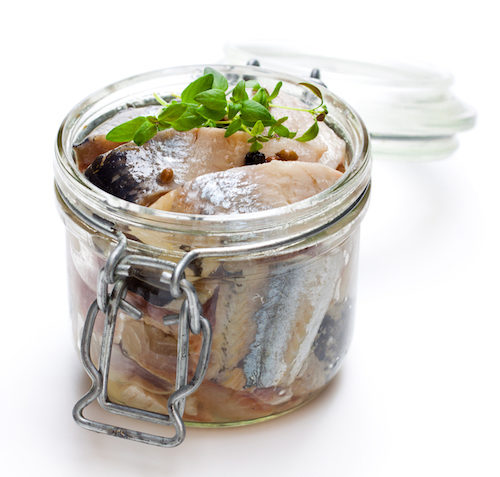
Rinse your salted herring, and omit salt from the brine. This Scandinavian pickled fish is great on toast, and you can add onions and lemon to the jar.
Watermelon Rind
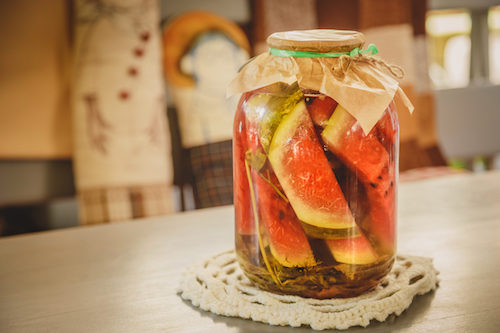
Add extra sugar, ginger and star anise to your brine for this Southern specialty. Instead of tossing watermelon rinds, just peel off the hard skin and turn them into a tangy treat.
Eggs and Beets
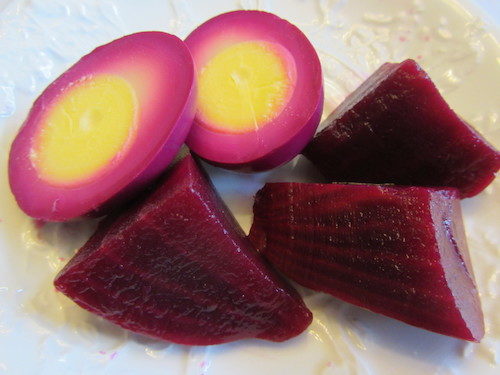
Pickling hard-boiled eggs and sliced beets together will give you brightly colored eggs perfect for the Easter table.
Cabbage
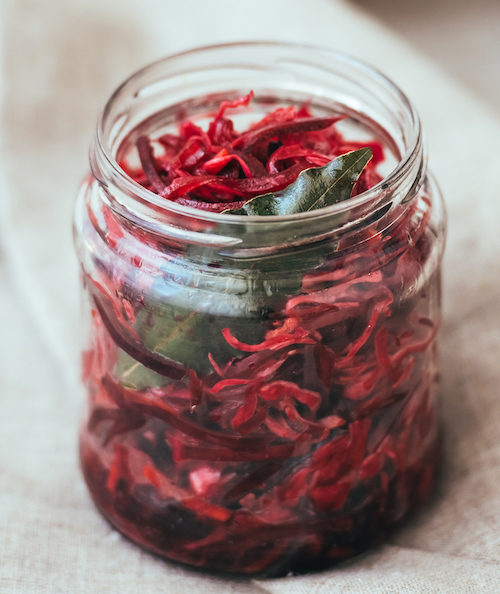
Thinly-sliced red cabbage will make a great pickled side dish for heavy meat dishes. Combine Napa cabbage with onions and spices to make a simple Korean kimchi.
Radish, Carrots, and Garlic
A fresh take on bread and butter pickles can be made with radishes and carrots instead. Cut them into 1/4-inch coins and blanch before pickling with dill seed, red pepper flakes, and crushed garlic cloves.
Eggplant
You’ll want to salt and drain eggplant first to draw out some of its moisture, but it pickles well with mint, oregano, red peppers, and olive oil.
Chef Curtis Stone’s Spring Fling
Spring is one of the most exciting changes of seasons. Emerging from cold weather, people begin to get out and about again. As a chef, I practically live at the farmers market, chatting with growers about the best produce on offer for the week and taking advantage of the bounty of fresh fruits and vegetables.
Early spring peas fresh from a local grower seem to taste sweeter than any available later in the year. When wild garlic leaves become available, I add the herb to everything from salads to mashed potatoes. In March, I go mad for asparagus that floods our markets. I like to steam the spear in a bamboo steamer. First, I flavor the water with ginger, garlic, and Chinese cooking wine, and then allow steam to permeate the asparagus.
There is nothing better than getting together with friends and enjoying a light flavor-filled meal gathered around the table. That’s what spring is all about. Angel Hair Pasta with Clams, Radishes, and Spinach is my healthy version of spaghetti with clams (spaghetti alle vongole). By limiting the pasta and increasing the vegetables, the dish not only tastes great but looks great too. After a visit to the farmers market, I can’t wait to whip up Quick-Braised Spring Vegetables — featuring peas, fava beans, asparagus, and baby spinach. It’s a testament to the season.
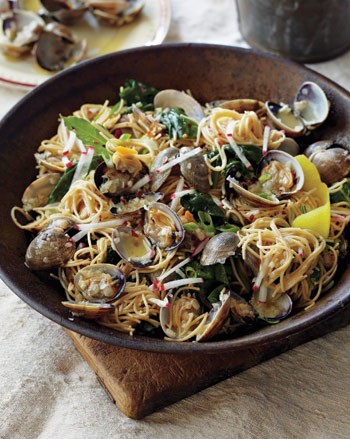
Photo by Quentin Bacon
Angel Hair Pasta with Clams, Radishes, and Spinach
(Makes 4 servings)
8 ounces whole-wheat angel hair pasta
1/4 cup extra-virgin olive oil, plus more for serving
2 pounds Manila or littleneck clams, scrubbed
1/3 cup finely chopped shallots
6 garlic cloves, finely chopped Zest of 1 lemon, removed in wide strips with a vegetable peeler
1 fresh or dried bay leaf
1/2 teaspoon red pepper flakes
1 cup dry white wine Kosher salt and freshly ground black pepper
3 ounces fresh baby spinach (about 4 cups loosely packed)
4 large radishes, cut into small matchstick-size strips (about 1/2 cup)
2 scallions (white and green parts), thinly sliced on the diagonal
Bring large pot of salted water to boil over high heat. Stir pasta into boiling water and cook, stirring often to keep strands separated, for about 2 minutes or until tender but still firm to bite. Scoop out and reserve ½ cup of pasta cooking water. Drain pasta.
Meanwhile, heat large heavy skillet over high heat. Add 1 tablespoon olive oil, add clams, and cook for 1 minute. Stir in shallots, garlic, lemon zest, bay leaf, and red pepper flakes. Add wine, cover, and cook for about 2 minutes, or until clams open. Using tongs, transfer clams to large bowl and cover to keep warm.
Simmer clam-wine broth until reduced by about one-fourth, about 2 minutes (pasta will absorb a lot of liquid, so don’t reduce too much). Stir in remaining 3 tablespoons olive oil and season with salt and pepper. Reduce heat to low.
Add pasta to skillet and toss to coat with liquid. Add clams and any accumulated juices in bowl to pasta. Add spinach and half of radishes and toss, adding enough of reserved pasta water to make a light sauce.
Using tongs, divide pasta and clams among four wide pasta bowls or place them in one large shallow serving bowl. Pour in broth. Drizzle olive oil over each serving and sprinkle with scallions and remaining radishes. Discard lemon zest and bay leaf and serve immediately.
Per serving
Calories: 419
Total Fat: 15 g
Saturated Fat: 2 g
Sodium: 236 mg
Carbohydrate: 51 g
Fiber: 9 g
Protein: 14 g
Diabetic Exchanges: 3 ½ starch, ½ vegetable, ½ lean meat, 3 fat
Quick-Braised Spring Vegetables
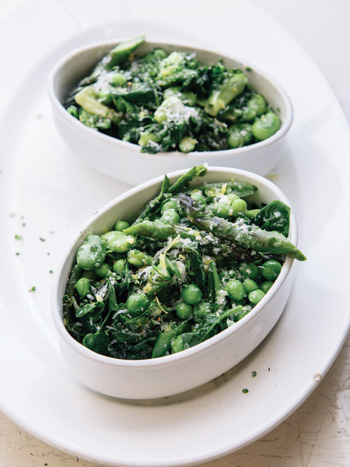
Photo by Ray Kachatorian
(Makes 6 servings)
1 spring onion or 4 scallions, trimmed and sliced
2 garlic cloves, finely chopped
3 tablespoons olive oil
3 tablespoons low-sodium chicken broth or water
8 ounces asparagus, woody ends trimmed, stalks cut into 1 1/2-inch pieces
1 cup shelled fresh fava beans (from about 1 pound pods), peeled (see Note), or sugar snap peas, trimmed and halved crosswise
1 cup shelled fresh English peas (from about 1 pound peas in the pod)
1/2 head escarole, torn into bite-size pieces (about 2 cups)
3 cups loosely packed baby spinach leaves
1/2 cup loosely packed fresh basil leaves
1 tablespoon grated lemon zest
1 tablespoon fresh lemon juice Kosher salt
1 tablespoon finely chopped fresh chives
Small chunk of Parmesan cheese, for grating
In large heavy skillet, combine spring onion, garlic, oil, and broth and bring to simmer over medium heat. Cover and cook for about 2 minutes, or until spring onion softens slightly.
Add asparagus, fava beans, and peas and sauté for about 2 minutes, or until beans and peas are heated through. Add escarole, spinach, and basil and sauté for about 2 minutes, or until escarole wilts and asparagus is crisp-tender.
Stir in lemon zest and juice. Season to taste with salt. Transfer to serving platter. Sprinkle with chives, grate Parmesan over, and serve immediately.
NOTE: Fava beans have an inedible pod and an outer skin that is edible only when beans are very young. To prepare fava beans, remove beans from pods. Next, bring large pot of water to boil.
Add beans and cook for 30 seconds. Immediately transfer beans to bowl of ice water. When chilled, drain beans and, using your fingers or small knife, peel outer skins from beans.
Per serving
Calories: 144
Total Fat: 8 g
Saturated Fat: 1 g
Sodium: 340 mg
Carbohydrate: 13 g
Fiber: 5 g
Protein: 6 g
Diabetic Exchanges: ½ starch, ½ vegetable, 2 fat
Excerpted from Good Food, Good Life by Curtis Stone. Copyright © 2015 by Curtis Stone. Excerpted by permission of Ballantine Books, a division of Random House LLC. All rights reserved. No part of this excerpt may be reproduced or printed without permission in writing from the publisher.
This article is featured in the March/April 2017 issue of The Saturday Evening Post. Subscribe to the magazine for more art, inspiring stories, fiction, humor, and features from our archives.
Sardines with Kale and Pasta
Budget-friendly sardines are a delicious, healthy, and safe seafood option that are too often overlooked. The little fish are full of omega-3 fats, vitamin B12, vitamin D, and calcium. Low on the food chain, sardines eat plants, not other fish, so they don’t have the mercury and other potential toxic load of some seafood.
This recipe calls for sardines packed in tomato sauce, but you can also use those packed in olive oil (this will result in a little more fat). If you can find fresh sardines, you may remove the bones by splitting or butterflying them. But you don’t have to debone them. Gently rub off the scales, remove the head and innards with a small paring knife and rinse. Then they are ready to cook.
One note of caution if you are using fresh sardines: These little fish can easily spoil if stored too long, even in the freezer. So use them within one or two days.
Sardines with Kale and Pasta
(Makes 4 servings)
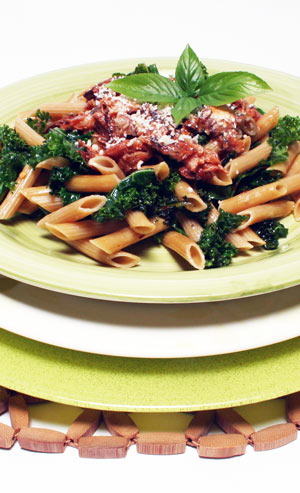
Ingredients
- 8 kale leaves, stems removed, torn into 1-inch pieces
- 1½ teaspoons olive oil
- 4 cloves garlic, minced
- ¼-½ teaspoon red pepper flakes or to taste
- Salt and freshly ground black pepper
- 8-ounce whole-grain penne cooked according to package instructions (other short or long pasta may be substituted)
- 12-ounce canned sardines packed in tomato sauce (can sizes typically vary from 3.75 to 4 ounces and larger)*
- 4 tablespoons Parmesan cheese, finely grated (pecorino may be substituted)
*Sardines canned in olive oil or cooked fresh sardines may be used with ½ cup tomato sauce.
Directions
- In large covered pot steam kale in 1/2-inch water until softened, about 3-4 minutes. Set aside.
- In large saucepan over medium heat add oil, garlic, kale, and red pepper flakes and season with salt and pepper to taste.
- Sauté mixture until kale wilts, stirring occasionally, about 5 minutes. Add cooked pasta and stir gently until heated through.
- Spoon mixture on four plates and arrange sardines on top. Dust with cheese and serve immediately.
Nutrition Facts
Per serving
Calories: 380
Total fat: 13 g
Saturated fat: 3.5 g
Carbohydrate: 41 g
Fiber: 7 g
Protein: 28 g
Sodium: 449 mg
Caribbean Cabbage
The Scotch bonnet is the pepper of choice in the islands—although you can easily substitute any pepper, especially the habanero, in this recipe. Sautéing the whole pepper infuses the cabbage mixture with its spicy flavor. Those who enjoy even more heat can experiment with either adding an additional pepper or even some red pepper flakes. The honey and vinegar combine to add a sweet and sour quality that balances the heat of the pepper.
Caribbean Cabbage can be served warm, at room temperature, or even chilled depending on your preference. No matter how you decide to serve it, this side pairs well with chicken—either a freshly prepared bird or chilled leftovers. Add a pitcher of unsweetened iced tea and serve it up on the patio or terrace for a taste of the tropics.
Tip: To get the maximum nutritional value from cabbage it’s most effective to shred your own when preparing this dish. But If your schedule is tight, buy a bag of shredded cabbage. One head of cabbage equals about 8 cups shredded.
Caribbean Cabbage
(Makes 6 servings)
Ingredients
- 2 tablespoons extra virgin olive oil
- 1 medium onion, sliced thin
- 1 medium green bell pepper, diced
- 1 scallion, including green stem, sliced thin
- 2 cloves garlic, minced
- 4 sprigs fresh thyme
- 1 whole Scotch bonnet chile pepper or habanero pepper
- Salt and freshly ground black pepper
- ¼ cup white vinegar
- 2 tablespoons honey
- 1 medium green or red cabbage, tough outer leaves removed, cored and shredded (about 8 cups, shredded)
- 1 cup shredded carrots
- 1 plum tomato, diced
Directions
- In large skillet heat oil over high heat. Stir in onion, bell pepper, scallion, and garlic. Sauté until softened (about 5 minutes). Stir in thyme and whole Scotch bonnet pepper. Add salt and pepper to taste.
- In small pot on medium heat, warm vinegar, do not boil, and stir in honey, mixing well.
- Add cabbage and carrots to onion mix. Stir to combine well, cover skillet and cook over medium-low heat, stirring occasionally, until cabbage begins to soften (about 10 minutes).
- Stir in vinegar-honey sauce and tomato into vegetable mixture. Continue stirring until cabbage is tender, about 4 minutes more or until desired tenderness. Remove the Scotch bonnet pepper and thyme sprigs. Serve. (Although typically served warm, you can also refrigerate to cool before serving.)
Nutrition Facts
Per serving
Calories: 130
Total fat: 5 g
Saturated fat: 0.5 g
Carbohydrate: 21 g
Fiber: 4 g
Protein: 3 g
Sodium: 60 mg
Kick-Off Kabobs
If you’re searching for a delicious but easy appetizer to kick off your next party, give these spicy kabobs a try. The recipe comes to us courtesy of the National Pork Board.
Kick-Off Kabobs
(Makes 24 appetizers.)
Ingredients
- 2 pounds boneless pork chops, cut into 1-inch cubes
- 1 cup Italian dressing
- 2 tablespoons dried red pepper flakes
- 1 tablespoon fennel seed
- 1 large red bell pepper, cut into 1-inch pieces
- 1 large green bell pepper, cut into 1-inch pieces
- 1 large onion, cut into 1-inch pieces
- 24 6-inch wooden skewers
Directions
- Place pork cubes in resealable plastic bag; add salad dressing, red pepper flakes, and fennel seed. Seal bag; refrigerate for at least 1 hour to overnight to marinate pork.
- When ready to cook, thread pork, peppers, and onion on skewers. Discard marinade.
- Place kabobs on greased broiler pan and broil 5 inches from heat or grill over medium-hot coals for about 5 minutes per side.
Nutrition
Calories: 70 calories
Protein: 9 grams
Fat: 2 grams
Sodium: 135 milligrams
Cholesterol: 25 milligrams
Saturated Fat: 0 grams
Carbohydrates: 2 grams
